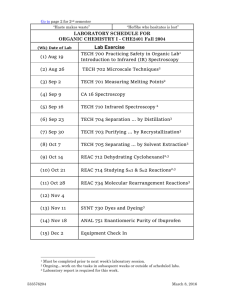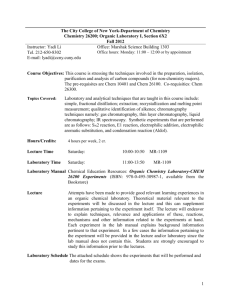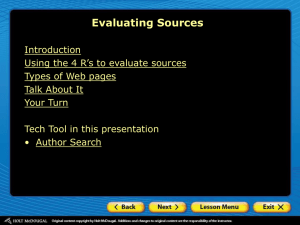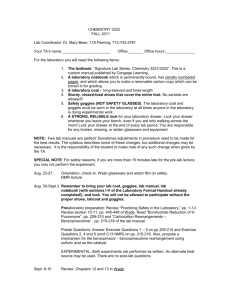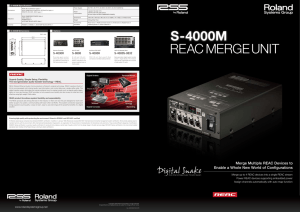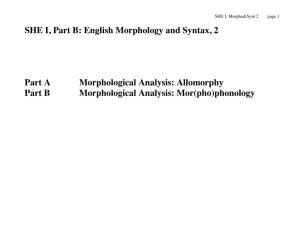Chemistry 226 - Nicholls State University
advertisement
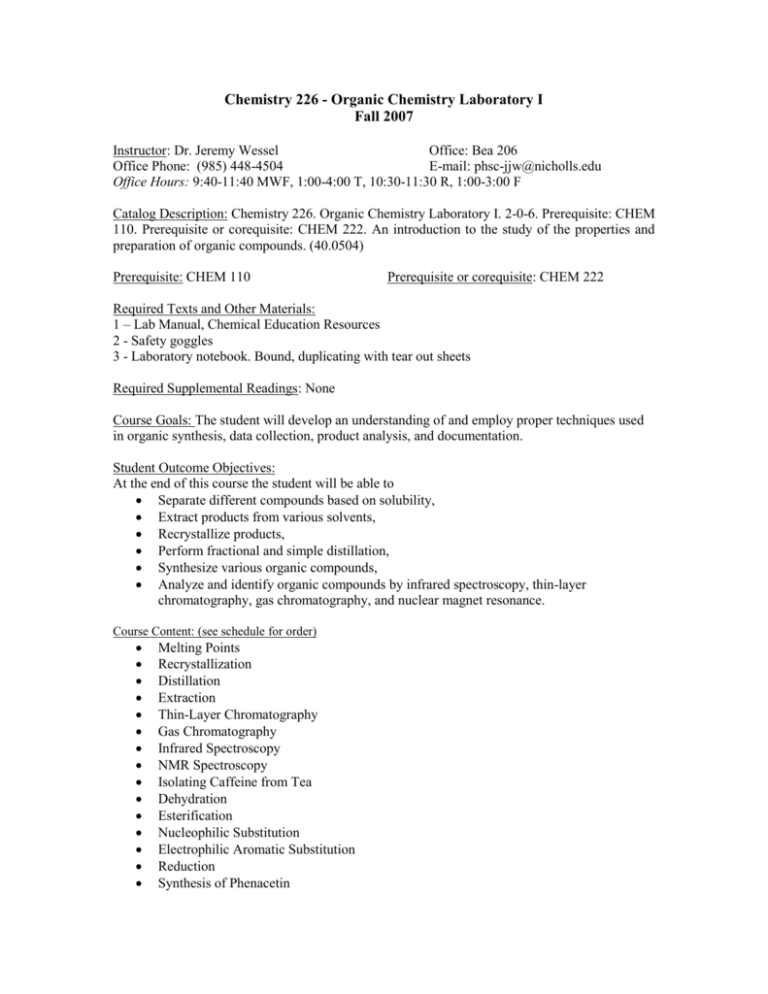
Chemistry 226 - Organic Chemistry Laboratory I Fall 2007 Instructor: Dr. Jeremy Wessel Office: Bea 206 Office Phone: (985) 448-4504 E-mail: phsc-jjw@nicholls.edu Office Hours: 9:40-11:40 MWF, 1:00-4:00 T, 10:30-11:30 R, 1:00-3:00 F Catalog Description: Chemistry 226. Organic Chemistry Laboratory I. 2-0-6. Prerequisite: CHEM 110. Prerequisite or corequisite: CHEM 222. An introduction to the study of the properties and preparation of organic compounds. (40.0504) Prerequisite: CHEM 110 Prerequisite or corequisite: CHEM 222 Required Texts and Other Materials: 1 – Lab Manual, Chemical Education Resources 2 - Safety goggles 3 - Laboratory notebook. Bound, duplicating with tear out sheets Required Supplemental Readings: None Course Goals: The student will develop an understanding of and employ proper techniques used in organic synthesis, data collection, product analysis, and documentation. Student Outcome Objectives: At the end of this course the student will be able to Separate different compounds based on solubility, Extract products from various solvents, Recrystallize products, Perform fractional and simple distillation, Synthesize various organic compounds, Analyze and identify organic compounds by infrared spectroscopy, thin-layer chromatography, gas chromatography, and nuclear magnet resonance. Course Content: (see schedule for order) Melting Points Recrystallization Distillation Extraction Thin-Layer Chromatography Gas Chromatography Infrared Spectroscopy NMR Spectroscopy Isolating Caffeine from Tea Dehydration Esterification Nucleophilic Substitution Electrophilic Aromatic Substitution Reduction Synthesis of Phenacetin The Aldol Condensation Course Requirements: All students will perform experiments using proper safety practices. Notebook: 25 points/experiment 13 experiments 325 points Aldol experiment formal report 50 points Midterm Exam 100 points Final Exam 100 points 575 points Method of Evaluation: Grades will be determined using the following scale: A: 90-100 B: 80-90 C: 70-80 D: 60-70 F: <60 Make-up Policy: Missed labs can be made up for an excused absence. Make-ups must be completed within two weeks of the experiment date. Attendance Policy: Attendance is mandatory. Academic Honesty Policy: Anyone found cheating will be subject to the penalties stated in Student Code of Conduct including but not limited to a score of zero on exam, expulsion from the class or expulsion from the University. Semester Withdrawals: The last day to withdraw from the class with a ‘W’ is October 26, 2007. Academic Disabilities Policy: If you have a documented disability that requires assistance, you will need to register with the Office of Disability Services for coordination of your academic accommodations. The Office of Disability Services is located in Peltier Hall, Room 100-A. The phone number is (985) 448-4430 (TDD 449-7002). Class Disruptions: The use of cellular phones, pagers or any other electronic personal device is prohibited in class. Any infractions will result in dismissal from class and 0 for the experiment. Academic Grievances: The proper procedure for filing grade appeals or grievances related to academic matters is listed in Section 5 of the Code of Student Conduct and at the following link: http://www.nicholls.edu/documents/student_life/code_of_conduct.pdf. Continued Learning following an Extreme Emergency: In order to make continued learning possible following an extreme emergency, students are responsible for: • reading regular emergency notifications on the NSU website; • knowing how to use and access Blackboard (or university designated electronic delivery system); • being familiar with emergency guidelines; • evacuating textbooks and other course materials; • knowing their Blackboard (or designated system) student login and password; • contacting faculty regarding their intentions for completing the course. Faculty are responsible for: • their development in the use of the Blackboard (or designated) software; • having a plan for continuing their courses using only Blackboard and email; • continuing their course in whatever way suits the completion of the course best, and being creative in the continuation of these courses; • making adjustments or compensations to a student’s progress in special programs with labs, clinical sequences or the like only in the immediate semester following the emergency. NOTEBOOK Prelab ANSWERS TO PRELAB QUESTIONS from manual In Notebook: TITLE and DATE PURPOSE: Describe what is expected of the laboratory. This should be only one or two sentences, in your own words--do not copy from the manuals. DATA TABLE: Listing of all of the reagents and solvents used in the experiment as well as the products. List in table form only. Include all data you need for the experiment or report. (You’ll need to develop judgment to decide relevance.) Also copies of reference spectra when appropriate. Note potential hazards. Chemfinder (http://chemfinder.cambridgesoft.com/) is a good reference, as are the CRC Handbook, Merck Index, and Aldrich catalog (available outside my office). CHEMICAL EQUATIONS (IF ANY): Write all of the major chemical reactions and side reactions for the experiment. Include the amounts called for in the experiment, determine which is the limiting reagent and determine the theoretical yield. In lab PROCEDURE/OBSERVATIONS – write down what you do and what happens as you do it Report spectral data in table form: for NMR Chemical Shift (ppm) Integration Multiplicity for IR Wavenumber Description Functional Grp Postlab CALCULATIONS: Show all your work. Must be legible and organized. CONCLUSION: Report final results (positive or negative) and what evidence was used to make conclusions. (Compare with PURPOSE.) ANSWERS TO POSTLAB QUESTIONS DISCUSSION: Discuss any results not covered already in the postlab questions REFERENCES: Proper citation of all material used in writing the report or to gather background material. Journal Citation: authors (last name, first name), title of journal, year of publication volume, page number Example: Smith, R. A.; Jones, M. J. J. Am. Chem. Soc. 1965, 80, 295. Notebooks must be written legibly to avoid loss of points. Schedule of Experiments Day 20 August Experiment Check In/Safety Day 22 August 27 August 3 September 10 September 17 September TECH 703 Recrystallization Labor Day Holiday TECH 705 Extraction TECH 707/TECH 709 TLC/GC Review SYNT 732 Isolating Caffeine SYNT 713 Esterification 29 August 5 September 12 September 19 September 17 October 22 October 29 October 5 November 12 November REAC 714 SN1 & SN2 Reactions REAC 716 Nitration REAC 715 Reduction SYNT 726 Phenacetin SYNT 720 Aldol Condensation 19 November 26 November Thanksgiving Vacation Review/Check Out 21 November 28 November 24 September 1 October 8 October 15 October 26 September 3 October 10 October 24 October 31 October 7 November 14 November Experiment TECH 701 Melting Points TECH 704 Distillation TECH 704 Distillation TECH 705 Extraction TECH 710/TECH 711 IR/NMR Midterm REAC 712 Dehydration SYNT 713 Esterification REAC 714 SN1 & SN2 Reactions REAC 716 Nitration REAC 715 Reduction SYNT 726 Phenacetin SYNT 720 Aldol Condensation Thanksgiving Vacation Lab Final
